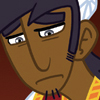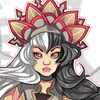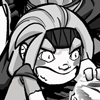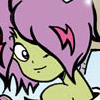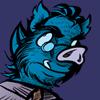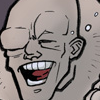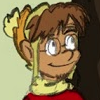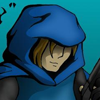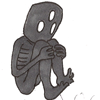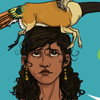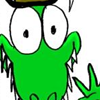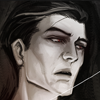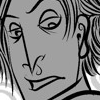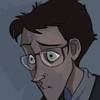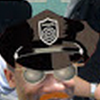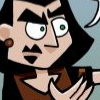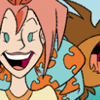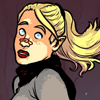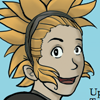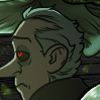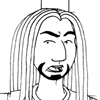Monthly Archives: November 2013
Ultra Mammoth
So sometimes webcomics have side-stories. They can be like Something Positive or Weregeek where they’re table top games the characters are playing, or like Johnny Wander or Ctrl+ Alt+ Delete where it’s just something else the author wanted to share. Depending on how well they’re executed, and the comic in question, it can be entertaining. It works with Johnny Wander (Although I cannot wait for Lucky Penny to end. It’s not bad but who puts up a long form graphic novel only two pages a week? Expect a review from me when it finally ends) since they’re just one off auto-bio comics and the sides are usually only a few pages long. With Weregeek, however, I found the RPG stuff so boring I quit halfway through my archive trawl of the comic.

Today, we’re looking at Ultra-Mammoth, a side story in David Willis’ Shortpacked that went for a few week. It was a fan fiction comic about the Transformers show Beast Wars. Specifically, one of the characters made to be sold as a toy, but never featured in the show. In the show, new characters were introduced by having the crew of the Maximal ship, who are the good guys, ejected and placed in orbit in the first episode. Occasionally, a pod falls from orbit and a new character awakens, unless the Predacons, the bad guys, get to it first and reprogram the bot inside.
Random Quickies: Thanos & Darkseid: Carpool Buddies of Doom

Darkseid: the Satan of the DC Universe. Dr. Doom: Marvel’s most recognizable villain. Thanos: … the guy that was in the post-credits sequence of the Avengers movie. No, not the shawarma scene. The… the other one. When these three villains are together in one place, you can expect… discussion about Breaking Bad. And The Wire. Basically, just three dudes hanging out in a car, passing the time. That’s how Justin Jordan and Rafer Roberts envision it in Thanos & Darkseid: Carpool Buddies of Doom.
Random Quickies: Star Wars: Age 9
I used to draw a comic when I was younger. It was called “Ninja Bears,” a pretty transparent reinterpretation of the Teenage Mutant Ninja Turtles. If, for any reason, one of those pages ever turned up again I would shriek in terror and then shred the paper maniacally.
John White (a professional illustrator) is far more game. He recently unearthed his comic adaptation that he worked on when he was between 9 and 14 years old. Rather than destroying his primitive efforts in a fit of embarrassment, he released everything online as Star Wars: Age 9.
Now, is this comic readable? Technically, yes. It’s actually impressive to see what a kid can accomplish with little formal training. (Though, to be fair, White does admit that a lot of his panels were copied straight from Howard Chaykin’s Marvel Comics adaptation.). At the end of the day, though, it’s still a comic written by a kid, and that’s hardly ever appointment reading.
The real fun is in the annotations. From rediscovering where he picked up certain lines that weren’t originally in the movies to cheeky observations on his own art, Star Wars: Age 9 is just as much a written record of the fandom and their wild, impressionable imaginations as it originally took hold in 1977. The tone is nostalgic and wistful, with a touch of bemusement and a whole lot of images of vintage collectibles.
The webcomic includes all new illustrated panels drawn by an older John White… But sadly, these pale to the originals. After all, can these new panels claim the bold artistic decision to incorporate a collectible bubble gum card? I think not.
WCO #233: Little Guardians

Fantasy is rooted a little bit in actual history. Most of the time, this means the European Middle Ages. Knights in shining armor, kings and queens, towering castles, and legends of dragons and elves. King Arthur stuff. However, there are tons of challenges in setting things at a certain era. As fantasy writer Poul Anderson once elaborated in his essay “On Thud and Blunder,” “Beneath the magic, derring-do, and other glamour, an imaginary world has to work right. In particular, a pre-industrial society, which is what virtually all hf uses for a setting, differs from ours today in countless ways.”
One of the things that writers often do is just ignore the historical nuisances. Don’t worry about people’s hair not looking perfect; just assume that everyone has access to soap, mirrors, and plumbing. Pay no attention that there are no city lights; our heroes can travel by night just as easily as by day. One of the biggest historical running blocks are the roles of women. Joan of Arc aside, women in the Middle Ages were typically not trained to be warriors. It was dudes. But, since in these days it’s not in the writer’s or the reader’s best interest that the adventurers be one big sausage party, fantasy authors tend to either ignore or minimize male chauvinism. Lady warriors just show up dressed in trousers made for men, and the townspeople rarely bat an eye.
The limited opportunities for women, though, is the driving narrative in Ed Cho and Lee Cherolis’ Little Guardians. The story centers around two characters: Subira, an unassuming shopkeeper’s daughter who has great potential, and Idem, an unlucky boy who’s training to be the next Guardian.
Of Cars and Contrivance
So last week I talked about how a strong villain can add to a story. This week, I have to go the other way and talk about a weak villain and some other flaws. The twelfth volume of the webcomic Misfile is generally considered one of the worst by the fans in the forums. There are others with weaker writing, more enraging moments and poorer art, but as a whole book, it’s easy to see what issues people can have.

Let’s start with a recap for the folks who don’t read Misfile. The comic is a low-fantasy transgender story about a teenage boy who becomes a girl, with the difference being that while it is sometimes played for comedy, the gender swap is usually deconstructed, showing the harsh reality that would occur. Also, it features car racing as Ash, our protagonist, is an amateur race car driver with two personally modified cars. He and many other kids from the nearby schools race each other on the weekends at a place called the Old Road, an abandoned strip on a mountain side. This means no cops to keep them from doing something illegal and dangerous. In the first volume, Ash won the title of ‘King of the Mountain’ given to the best driver in the school district.
In volume twelve, the boys who race on the Old Road are being challenged by a new driver with a bet that if they lose, they can no longer drive on the road again. Many boys lose and eventually this driver decides to stop them from racing all together. Ash is called in because as King, he has a duty to defend the track, even though he never agreed to such and the other boys admit they hate him. Ash beats the racer, only to discover the racer has a superior named Sheldon, who challenges Ash by proxy. Sheldon turns out to be wormy and bribes Ash to throw the race, but our hero doesn’t and learns about responsibility when he trounces Sheldon.
Now a few of you may be asking what is so bad about that. Well, note that I didn’t explain why Sheldon wants the track for himself. And that’s because no reason is given. We do get told that he’s recruiting but that doesn’t explain why he wants to take over the Old Road
And that’s the biggest problem with this arc. Nearly every storytelling issue in it can be boiled down to one simple word: “Why?”
Cameron Stewart on the stigma of webcomics
Cameron Stewart of Sin Titulo is embarking on a tour across Canada, the US, and England to promote the print version. Robot 6 guest contributor David Scheidt interviews him. Of particular interest to me is Mr. Stewart’s insights into the world of webcomics, and the differences in perceptions between webcomic audiences and traditional comics fans.
I hate to admit this, but I had no idea this comic existed until I saw it on the shelves at Challengers, and I’m fairly familiar with your work. I just assumed it was a new graphic novel you released that I somehow didn’t hear about.
It is new to a lot of people because there are a lot of people out there who just don’t like reading webcomics. There’s an opportunity there to treat it as a new book.
There definitely seems to be a distinction between webcomics readers and traditional comics readers. Where do you think Sin Titulo fits between those two worlds?
A lot of webcomics seem to be these humor strips or long-running, almost soap opera-type things. I didn’t want it to be a humor strip or something that I’d want to run indefinitely. I set out to do it as a finite story, even though I started it not knowing what it was gonna be. The end game was always to have it in print. I definitely like using the Internet for publishing comics — I think it’s a really, really valuable too, and in a way I think it’s much better than self-publishing. It’s closer in spirit to typical, printed graphic novels compared to other webcomics.
Yeah, It seems like a lot people already have a preconceived notion of what webcomics are. It’s great that more and more that different genres are popping up, since it’s just as capable a medium as print comics.
Absolutely. I think a lot of people kind of look down on webcomics. I won an Eisner Award for it [Sin Titulo] for the category Best Webcomic and it doesn’t really seem to me be fairly judged against other webcomics, but there’s a stigma kind of attached to them. Almost like they aren’t considered real comics. One of the things I wanted to do was, because I already had an established career in print comics with Marvel and DC and mainstream comics, I wanted to be if not the first, one of the early people to go and attempt a serious work on the web in that medium and to see if it was successful, and hopefully by doing that encourage other major names to do the same.
The stuff Mark Waid and all the creators at Thrillbent have been doing with digital comics, those could just as well be print comics but they are created and played to the strengths of the digital medium.I think there’s no distinction certainly between what’s possible in the medium. I don’t think there is any distinction really, between webcomics and print comics other than your reading them on a computer or tablet rather than in print. I think as time goes on, as digital comics grow in popularity, I think that distinction will fall away completely. I don’t think there will be a distinction between the two. It’ll just be the same thing.
Why is this interesting to me? Well, mainly because webcomics have been around two decades, and it seems folks are still talking about how the distinction between print and digital will fall away. Maybe so, but I think fans for Thrillbent and Comixology offerings will always be a distinct crowd from the webcomics group in the same way that fans of Marvel and DC aren’t necessarily the same fans as those of Peanuts and Calvin & Hobbes.
Know Thy History: Annie

Harold Gray’s Little Orphan Annie is one of those comic strips whose reputation in other media has eclipsed its original incarnation. The strip began in 1924 after debuting in the New York Daily News. Following the story of a naive young vagabond and her weird-looking dog named Sandy, Annie rose in popularity until it became the most popular comic strip in 1937 according to Fortune magazine.
![ANN_annie~sandy_shoulders_c [Converted]](https://webcomicoverlook.wordpress.com/wp-content/uploads/2013/11/annie.jpg?w=604)
The formula was simple: Annie got into some trouble with some malefactors, and her guardian, the famously bald-headed “Daddy” Warbucks, would swoop in to save the day. Rinse. Repeat. Still, for a very innocent strip, Little Orphan Annie made some powerful enemies thanks to Harold Gray’s brand of politics. Such as opponents of child labor. Hey, you lazy kids! Why don’t you go out and get a job like Annie, that little sweetheart?
Annie really did have a very colorful career. She fought gangsters and challenged crooked politicians. She commanded her own commando unit, which sounds crazy until you figure that Annie had a heck of a left hook. Also, in one instance, Annie blew up a Nazi sub. According to Susan Houston:
Her first mission is dramatic enough for any child on the home front longing for a real adventure. She and her friend Panda find a hidden U-boat in a nearby cove, and manage to drag a floating mine to dash against the hull and blow it up.
Hardcore.

Little Orphan Annie ended only a few years ago in 2010. Apparently our bright-haired moppet was left stranded in captivity on the very last strip. Also, she was wearing jeans and her hair was pulled back in a ponytail, a pretty transparent attempt at trying to modernize the character. It’s kinda like trying to put Mickey Mouse in baggy pants and a hoodie, though: the red frock and the clown wig is so iconic that anything else is not very Annie. (Fortunately, she was still rocking those blank, soulless eyes right to the end.) Hilariously, “Daddy” Warbucks declares her dead. The very last panel of Annie reads, “And this is where we leave our Annie. For Now—” Seriously, that’s probably one of the most depressing ways for a strip to end. Even Brenda Starr got to retire with dignity.
Her disappearance was referred to in Dick Tracy this year, where it’s implied that “Daddy” Warbucks may enlist the great detective’s help in trying to find her.

Annie was an orphan who lived in Dickensian squalor until she’s adopted by the Warbuckses. (For those of you who are only familiar with her later incarnations, she was initially taken in by a Mrs. Warbucks as a publicity stunt.) Mr. Warbucks would take a shining on the girl, and soon he would be known as “Daddy.” Eventually, Annie would be globe trotting and going on adventures, while “Daddy” would be doing stuff like faking his death because f*** you, FDR! You and your New Deal are the death of America.







